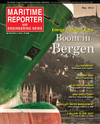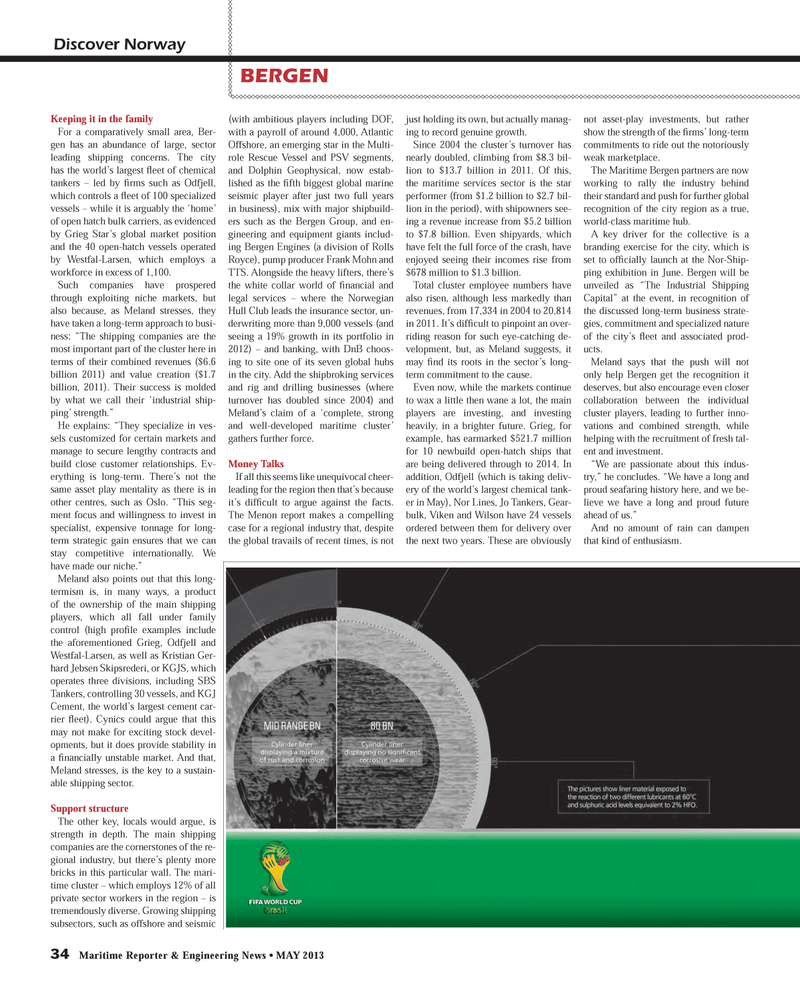
Page 34: of Maritime Reporter Magazine (May 2013)
Energy Production & Transportation
Read this page in Pdf, Flash or Html5 edition of May 2013 Maritime Reporter Magazine
34 Maritime Reporter & Engineering News ? MAY 2013 Keeping it in the familyFor a comparatively small area, Ber- gen has an abundance of large, sector leading shipping concerns. The city has the world?s largest ß eet of chemical tankers ? led by Þ rms such as Odfjell, which controls a ß eet of 100 specialized vessels ? while it is arguably the ?home? of open hatch bulk carriers, as evidenced by Grieg Star?s global market position and the 40 open-hatch vessels operated by Westfal-Larsen, which employs a workforce in excess of 1,100.Such companies have prospered through exploiting niche markets, but also because, as Meland stresses, they have taken a long-term approach to busi-ness: ?The shipping companies are the most important part of the cluster here in terms of their combined revenues ($6.6 billion 2011) and value creation ($1.7 billion, 2011). Their success is molded by what we call their ?industrial ship-ping? strength.? He explains: ?They specialize in ves-sels customized for certain markets and manage to secure lengthy contracts and build close customer relationships. Ev-erything is long-term. There?s not the same asset play mentality as there is in other centres, such as Oslo. ?This seg-ment focus and willingness to invest in specialist, expensive tonnage for long-term strategic gain ensures that we can stay competitive internationally. We have made our niche.?Meland also points out that this long-termism is, in many ways, a product of the ownership of the main shipping players, which all fall under family control (high proÞ le examples include the aforementioned Grieg, Odfjell and Westfal-Larsen, as well as Kristian Ger- hard Jebsen Skipsrederi, or KGJS, which operates three divisions, including SBS Tankers, controlling 30 vessels, and KGJ Cement, the world?s largest cement car- rier ß eet). Cynics could argue that this may not make for exciting stock devel-opments, but it does provide stability in a Þ nancially unstable market. And that, Meland stresses, is the key to a sustain-able shipping sector. Support structure The other key, locals would argue, is strength in depth. The main shipping companies are the cornerstones of the re-gional industry, but there?s plenty more bricks in this particular wall. The mari- time cluster ? which employs 12% of all private sector workers in the region ? is tremendously diverse. Growing shipping subsectors, such as offshore and seismic (with ambitious players including DOF, with a payroll of around 4,000, Atlantic Offshore, an emerging star in the Multi- role Rescue Vessel and PSV segments, and Dolphin Geophysical, now estab-lished as the Þ fth biggest global marine seismic player after just two full years in business), mix with major shipbuild-ers such as the Bergen Group, and en- gineering and equipment giants includ-ing Bergen Engines (a division of Rolls Royce), pump producer Frank Mohn and TTS. Alongside the heavy lifters, there?s the white collar world of Þ nancial and legal services ? where the Norwegian Hull Club leads the insurance sector, un- derwriting more than 9,000 vessels (and seeing a 19% growth in its portfolio in 2012) ? and banking, with DnB choos-ing to site one of its seven global hubs in the city. Add the shipbroking services and rig and drilling businesses (where turnover has doubled since 2004) and Meland?s claim of a ?complete, strong and well-developed maritime cluster? gathers further force.Money Talks If all this seems like unequivocal cheer- leading for the region then that?s because it?s dif Þ cult to argue against the facts. The Menon report makes a compelling case for a regional industry that, despite the global travails of recent times, is not just holding its own, but actually manag-ing to record genuine growth.Since 2004 the cluster?s turnover has nearly doubled, climbing from $8.3 bil-lion to $13.7 billion in 2011. Of this, the maritime services sector is the star performer (from $1.2 billion to $2.7 bil-lion in the period), with shipowners see-ing a revenue increase from $5.2 billion to $7.8 billion. Even shipyards, which have felt the full force of the crash, have enjoyed seeing their incomes rise from $678 million to $1.3 billion.Total cluster employee numbers have also risen, although less markedly than revenues, from 17,334 in 2004 to 20,814 in 2011. It?s dif Þ cult to pinpoint an over- riding reason for such eye-catching de-velopment, but, as Meland suggests, it may Þ nd its roots in the sector?s long- term commitment to the cause.Even now, while the markets continue to wax a little then wane a lot, the main players are investing, and investing heavily, in a brighter future. Grieg, for example, has earmarked $521.7 million for 10 newbuild open-hatch ships that are being delivered through to 2014. In addition, Odfjell (which is taking deliv-ery of the world?s largest chemical tank- er in May), Nor Lines, Jo Tankers, Gear- bulk, Viken and Wilson have 24 vessels ordered between them for delivery over the next two years. These are obviously not asset-play investments, but rather show the strength of the Þ rms? long-term commitments to ride out the notoriously weak marketplace.The Maritime Bergen partners are now working to rally the industry behind their standard and push for further global recognition of the city region as a true, world-class maritime hub. A key driver for the collective is a branding exercise for the city, which is set to ofÞ cially launch at the Nor-Ship- ping exhibition in June. Bergen will be unveiled as ?The Industrial Shipping Capital? at the event, in recognition of the discussed long-term business strate-gies, commitment and specialized nature of the city?s ß eet and associated prod- ucts.Meland says that the push will not only help Bergen get the recognition it deserves, but also encourage even closer collaboration between the individual cluster players, leading to further inno-vations and combined strength, while helping with the recruitment of fresh tal-ent and investment.?We are passionate about this indus- try,? he concludes. ?We have a long and proud seafaring history here, and we be-lieve we have a long and proud future ahead of us.?And no amount of rain can dampen that kind of enthusiasm.Discover NorwayBERGENMR #5 (34-41).indd 34MR #5 (34-41).indd 345/2/2013 9:42:46 AM5/2/2013 9:42:46 AM

 33
33

 35
35
